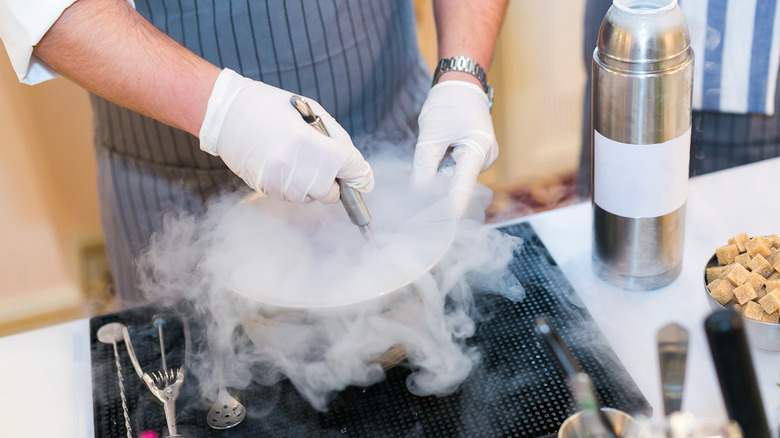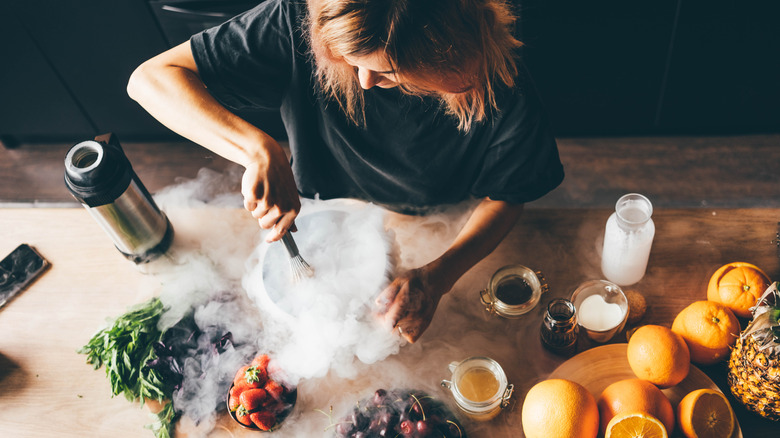Is It Dangerous To Use Liquid Nitrogen While Cooking?
Though liquid nitrogen stunts like the waffle-croissant hybrid at Creamistry seem fairly recent, we have news: The stuff was used in the 1800s to make ice cream (via Salon). Long before chefs wowed diners with foggy presentations and frozen squiggles of chocolate, a cookbook author named Agnes Marshall showed off her ice cream freezing technique in the early 1900s, reports Four Pounds Flour; yet liquid nitrogen didn't seem to catch on until the mid-1990s, thanks to cook and chemist Herve This.
Chef Steps explains that "cooking" with liquid nitrogen is kind of like setting ingredients into a deep fryer, but you're using the opposite end of the temperature spectrum – extreme cold – instead of sizzling heat. Wielded correctly, liquid nitrogen gives chefs temperatures and textures not readily available with more conventional cooking methods. According to Makezine, liquid nitrogen clocks in at minus 320.44 degrees Fahrenheit, which means boiling happens at room temperature, and food can be frozen quickly.
With such a quick freeze, the texture of food is preserved and the original structure of the item remains intact – even in something like a hamburger patty or raspberry, according to Scientific American. Yet as chef Eddie Shepherd warns, liquid nitrogen does have the potential to be harmful, and only those who have been trained or are being supervised by someone who has received appropriate training should try to flash-freeze fruit, herbs, candies, chocolate, or ice cream to serve.
Proceed with caution
When compared to sizzling oil, Modernist Cuisine insists liquid nitrogen isn't as dangerous, as chefs can set about creating crispy gels and crunchy meats without worrying about being burned by splashes. "And it helps us be so much more efficient," Chef Daniel Humm told Salon. "You don't have to wait for hours and hours if you want an ice cream, for example. You can make it instantly."
Food Hacks recognizes that eating anything dunked into liquid nitrogen may sound risky, but once liquid nitrogen has cooled off any food, it evaporates. Yet liquid nitrogen must be stored in special containers that are insulated and vented, and since there is a risk of frostbite, most chefs wear safety protection when handling the chilly vapor (via Thought Co.).
In 2021, the Courier-Journal reported an explosion inside one Dippin' Dots factory, the company that freezes ice cream into small pellets. At least 10 people were injured as a truck was unloading liquid nitrogen into a container. As mentioned, liquid nitrogen must be stored properly to accommodate expanding gas and pressure. "For this reason liquid nitrogen should not be enclosed in a sealed container, as this may result in it bursting or an explosion," the Kentucky Labor Cabinet's Office of Occupational Safety and Health advised the paper.
If you're wanting to experiment with this chilly culinary technique, we suggest doing so carefully. But if you're feeling nervous, you can try a no-bake frozen dessert recipe to serve after dinner instead.

